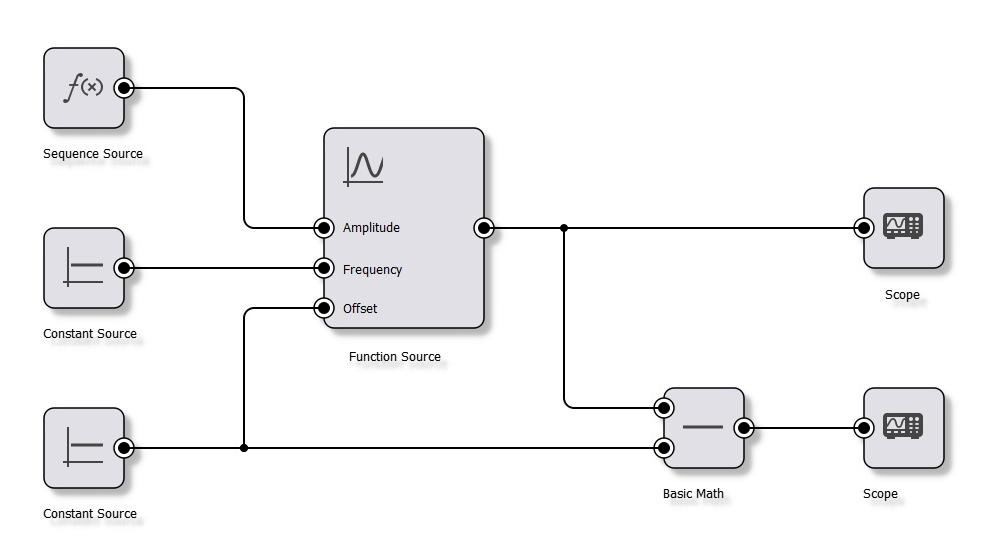QSchematic is a library to draw diagrams & schematics with Qt. It uses Qt's graphics view framework.
The library provides base classes for objects such as nodes and wires and implements logic to move objects around while keeping the wires connected, generating netlists and so on. A typical application would include this library and subclass the Item class to implement custom items.
Feature overview:
- Add, remove, move, resize nodes
- Connect nodes with wires
- Command stack for undo/redo
- Drag'n'Drop
- Netlist generator
- In-memory template generator
- JSON writer
- Custom writers
- Serialization to/from XML or YAML
- Completely customizable by inheriting from the provided classes
- Items
- All items support "highlighted" and an optional pop-up widget on hover
- Nodes
- Wires
- Straight
- Square
- Spline / Bezier
- Connectors
- Widgets (embed any
QWidgetinto the scene)
Technical stuff:
- Written in C++20
- Works with Qt5 and Qt6
- Everything is contained within the
QSchematicnamespace - MIT licensed
This library is MIT licensed.
This library was originally designed, implemented and maintained by Joel Bodenmann in 2015. It was handed over to Simulton GmbH in late 2018.
Special thank goes to Professor François Corthay (Switzerland) for initially privately funding this project.
The library allows complete customization of every visual aspect. Therefore, screenshots are not really a telling thing as they are just showing an application specific implementation of the paint functions. But meh... I guess people still want to see some stuff so here we go:



For more, check out the docs/screenshots folder.
This is built using cmake.
The following targets are provided:
| Target | Description |
|---|---|
qschematic-static |
Builds a static library. |
qschematic-shared |
Builds a shared/dynamic library. |
qschematic-demo |
Builds a simple demo application. |
Dependencies:
- A C++20 capable compiler
- Qt5 (>= 5.15) or Qt6
- GPDS for (de)serialization
If the cmake option QSCHEMATIC_DEPENDENCY_GPDS_DOWNLOAD is enabled (default), cmake will automatically pull the GPDS dependency.
Therefore, assuming a system with a working Qt5 or Qt6 installation, all you have to do is:
git clone https://github.com/simulton/qschematic
cd qschematic
cmake -B build
cmake --build buildThis library can be integrated easily into other cmake projects. There are two main mechanisms available:
- Using
FetchContent_Declare() - Install the library and use
find_package()
include(FetchContent)
# Fetch QSchematic
FetchContent_Declare(
qschematic
GIT_REPOSITORY https://github.com/simulton/qschematic
GIT_TAG master
)
FetchContent_MakeAvailable(qschematic)
# Link to your application/library
target_link_libraries(
my_app
PRIVATE
qschematic-static
)Note that any serious consumer might want to specify an actual git tag or a commit hash via GIT_TAG rather than a branch name.
To change options & variables, the call to FetchContent_MakeAvailable() shown above can be replaced with:
FetchContent_Declare(
qschematic
GIT_REPOSITORY https://github.com/simulton/qschematic
GIT_TAG master
)
FetchContent_GetProperties(qschematic)
if(NOT qschematic_POPULATED)
FetchContent_Populate(qschematic)
set(QSCHEMATIC_BUILD_DEMO OFF CACHE INTERNAL "")
set(QSCHEMATIC_DEPENDENCY_GPDS_DOWNLOAD OFF CACHE INTERNAL "")
set(QSCHEMATIC_DEPENDENCY_GPDS_TARGET "gpds-shared" CACHE INTERNAL "")
add_subdirectory(${qschematic_SOURCE_DIR} ${qschematic_BINARY_DIR})
endif()The QSchematic static & shared library cmake targets are exported which allows for easy integration into a client application/library.
After successfully building & installing the QSchematic library targets, use find_package() to include the QSchematic targets and target_link_libraries() to add the corresponding target to your client application/library:
find_package(QSchematic REQUIRED)
add_executable(my_application "")
target_link_libraries(my_application qschematic::qschematic-static)
Use the cmake scripts that ship with this library to build either the static library (cmake target qschematic-static) or the shared library (cmake target qschematic-shared) and link the resulting library into your client application/library using whatever mechanism the build system of your choosing provides.
Did someone say UML?!
The class diagramm below shows the overall architecture of the system:

All items that are part of the Scene inherit from the Item class. There are built-in specialized classes for nodes, wires and so on:
